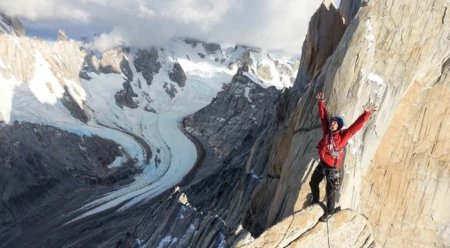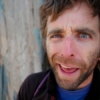Perched On A Wild Border
Sometimes when I look at the Fitz Roy Range, I see a silhouetted jawline of mountainous teeth that gnash the sky. Other times, the teeth transform to fingers that don’t crush aspirations but cradle them, like a hand cupping something precious. The distinction really depends on whether I’m looking at the mountains from the relative safety of camp while they are ensnarled in storms or if I’m peering out from inside the tempest.
When I was a teenager, I would clip out iconic images from the Patagonia catalogs and pin them to the walls above my bed. As one of nine kids from an East Coast working-class family, my chances of ever getting there seemed slim.
Decades later, I was driving across the Nevada desert with Nathan Martin, bound for an ascent of the notorious Sea of Dreams on El Capitan’s southeast face, when he mentioned his upcoming trip to Patagonia. After years spent cutting my teeth on miles of predictable multipitch climbs, I felt ready to visit one of the world’s great ranges—a place as storied for its beckoning jagged monoliths as it was for its inglorious tragic failures.
Nathan was an old hand at 26, having been on two trips already with the legendary Charlie Fowler. I, on the other hand, was green and also black and blue after accidentally tumbling down a moraine, almost to my death—an inauspicious start to my budding alpine tutelage. In such a volatile landscape, the curve is steep and the margin thin. Yet after numerous trials and failures, snubbed by rain, wind and exhaustion, we eventually donned the audacious laurels of the first ascent.
The route ascends a series of splitter, gaping cracks up the west face of Fitz Roy. We carried the requisite ropes, rack and packs on our backs, plus two immense pieces of protection to subdue the offwidth. Our first night, we scraped a bivy platform in the snow and gravel, and hunkered down in sleeping bags atop thin pads.
Early the next day, as we approached the top, we made our way cautiously across the verglas-coated gendarmes that mark the junction with the California Route. As I clipped the occasional timeworn piton, I wondered if one of the original fun hogs had placed it and if I was clipping a piece of history while making my own. The summit was bluebird. We were ragged and euphoric but the worst was yet to come.
On the descent, we discovered the forlorn body of a solo climber who recently went missing, and as the sun warmed the matrix of ice and stone above us, it ricocheted, in accompaniment, down the couloir. We spent that night, first cowering then snoring, on a sloping ledge beneath an overhang. When we finally reached a remote dirt-floor cantina after another night out, we ate and drank slowly, with the numbed fatigue of survivors.
I realized later that even though gravity and the elements are indifferent to who goes first, who comes home or who stays behind, perhaps Nathan and I would remain a permanent mixture of all three. We called our route Tonta Suerte, Spanish for “dumb luck,” a nod as much to the fortunate window of weather as to avoiding the chop.
A couple seasons ago I was back in El Chaltén after a lengthy hiatus—a particularly disheartening year with almost no viable climbing opportunities. After another beatdown with my climbing partner Niels Tietze, a young, gifted Yosemite gun, we pulled all our gear from high camp and headed back to town. As we sat sipping bodega beers, one of the wild-haired street dogs ambled over and promptly curled in a ball at our feet. Everything seemed to hunker down there.
Some groused that the town had changed since my last visit—paved streets, microbreweries, ample rooms. But I was struck instead by the folly of city planning in contrast to the savage beauty of those untamable mountains. These granite sentinels allow us to walk among them, even to momentarily stand on their summits, but they will never be conquered. Niels, who seemed invincible, sadly met his end on his beloved Yosemite granite. It’s us climbers that change while the mountains hold.

